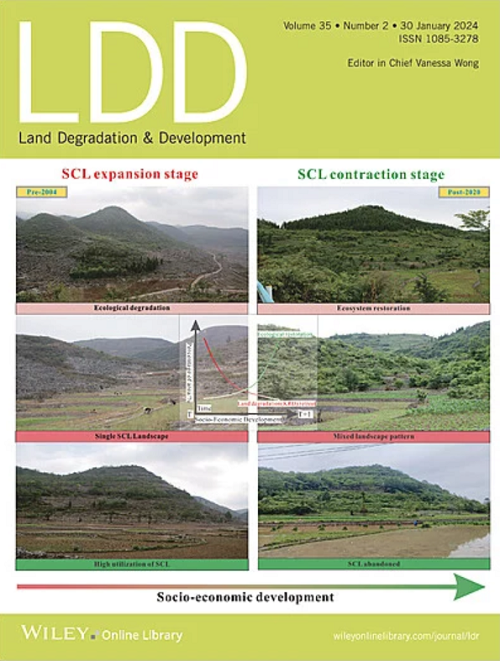氮肥和氮生物肥对甘蔗单作系统土壤真菌群落的短期影响
IF 3.7
2区 农林科学
Q2 ENVIRONMENTAL SCIENCES
引用次数: 0
摘要
土壤真菌群落对养分循环至关重要,但它们对农业系统中结合化学和生物成分的各种土壤改型的反应仍未得到充分研究。本研究评价了单施合成氮肥尿素(CF: 150 kg ha - 1)和配施不同生物肥(BF)比率(BF1: BF 1000 kg +尿素150 kg、BF2: BF 1500 kg +尿素150 kg、BF3: BF 1000 kg +尿素100 kg、BF4: BF 1500 kg +尿素100 kg)对甘蔗形态和根际真菌群落的影响。结果表明,所有生物肥料处理显著(p <;0.05)增强了甘蔗的形态,其中BF2对茎粗(1.5倍)、叶片生物量(3.91倍)、甘蔗生物量(3.07倍)和根冠比(>;3倍)与对照(不施肥)相比。扩增子测序结果显示共有328个操作分类单元(otu),其中BF4共有175个。α多样性分析结果显示,BF3真菌多样性最高,而BF1真菌丰富度最高。在不同的处理中,子囊菌门是优势门,而BF4使肾小球菌门的相对丰度提高了2.3倍,使镰刀菌门的相对丰度降低了2倍。BF4还富集了真菌和木霉等分类群,增强了真菌群落与铵水平的相关性。土壤全氮与真菌群落组成密切相关,表明生物肥料培养了养分循环所必需的关键真菌类群。这些发现强调了将生物肥料与减少尿素投入相结合以增强土壤微生物健康和支持可持续农业的潜力。本文章由计算机程序翻译,如有差异,请以英文原文为准。
Short‐Term Impacts of Nitrogen and Nitrogen‐Biofertilizer Amendments on Soil Fungal Communities in Sugarcane Monocropping Systems
Soil fungal communities are essential for nutrient cycling, yet their responses to various soil amendments that combine chemical and biological components in agricultural systems remain underexplored. This study evaluated the effect of synthetic nitrogen (N) fertilizer urea alone (CF: 150 kg ha−1 ) and in combinations with different biofertilizers (BF) rates, that is, BF1: BF 1000 kg + urea 150 kg, BF2: BF 1500 kg + urea 150 kg, BF3: BF 1000 kg + urea 100 kg, and BF4: BF 1500 kg + urea 100 kg (all rates per hectares) on sugarcane morphology and rhizosphere fungal communities. Results showed that all biofertilizer treatments significantly (p < 0.05) enhanced sugarcane morphology, with BF2 showing the greatest enhancement in stem diameter (1.5‐fold), leaf biomass (3.91‐fold), cane biomass (3.07‐fold), and root‐to‐shoot ratio (> 3‐fold) compared to the control (no fertilizers). Amplicon sequencing revealed 328 shared operational taxonomic units (OTUs), with BF4 having the most unique OTUs (175). Alpha diversity analysis revealed that BF3 had the highest fungal diversity, while BF1 showed the highest richness. Ascomycota was the dominant phylum across treatments, while BF4 increased the relative abundance of Glomeromycota by 2.3‐fold and reduced Fusarium by 2‐fold compared to control. BF4 also enriched taxa such as Agaricomycetes and Trichoderma , and strengthened the correlation between fungal communities and ammonium levels. Soil total N was strongly associated with fungal community composition, suggesting that biofertilizers foster key fungal taxa essential for nutrient cycling. These findings highlight the potential of integrating biofertilizers with reduced urea input to enhance soil microbial health and support sustainable agriculture.
求助全文
通过发布文献求助,成功后即可免费获取论文全文。
去求助
来源期刊

Land Degradation & Development
农林科学-环境科学
CiteScore
7.70
自引率
8.50%
发文量
379
审稿时长
5.5 months
期刊介绍:
Land Degradation & Development is an international journal which seeks to promote rational study of the recognition, monitoring, control and rehabilitation of degradation in terrestrial environments. The journal focuses on:
- what land degradation is;
- what causes land degradation;
- the impacts of land degradation
- the scale of land degradation;
- the history, current status or future trends of land degradation;
- avoidance, mitigation and control of land degradation;
- remedial actions to rehabilitate or restore degraded land;
- sustainable land management.
 求助内容:
求助内容: 应助结果提醒方式:
应助结果提醒方式:


